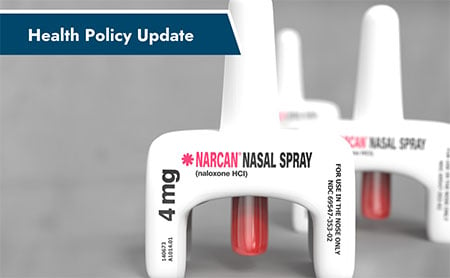Prevention and Response Policies to Reduce Overdoses Involving Synthetic Opioids
August 25, 2025 | JoAnne Deehr

For the first time in over a decade, rates of fatal overdoses began to decline in 2023 and provisional data for 2024 shows an even sharper decrease. Various factors may have contributed to the continued decline in overdose deaths including changes in the illicit drug supply, the widespread distribution of naloxone, improved access to evidence-based treatment for substance use disorders, and access and distribution of drug checking equipment (DCE) such as fentanyl test strips.
While this decline is promising, overdose remains the leading cause of death for Americans ages 18-44 and synthetic opioids, such as fentanyl, remain a leading cause of overdose deaths overall. More than 48,400 overdose deaths in 2024 involved synthetic opioids, accounting for nearly 60% of all overdose deaths.
To continue reducing fatal overdose rates, states and territories are considering legislation bolstering access to DCE and comprehensive drug screening at hospital emergency departments.
Lifesaving Prevention Measures Evolve
Jurisdictions have implemented overdose prevention and response practices, including legislation that supports the use of DCE like fentanyl test strips. Studies have shown that their use reduces risk of overdose among people who use drugs. As of August 2024, fentanyl testing equipment is authorized in 46 states and Washington, D.C. However, not all jurisdictions allow for broad use of DCE. While at least 29 jurisdictions support access to all types of DCE, others limit the definition to the detection of specific substances such as fentanyl.
In 2025, at least six states explored legislation related to DCE, including several bills that would expand the scope of authorized DCE. At least two states enacted laws expanding the scope of DCE, including in Virginia (HB 2319) and Louisiana (SB 78), where authorized DCE now includes products or equipment that detect any dangerous substance, chemical compound, or contaminant "that can cause physical harm or death,” not just fentanyl. Iowa considered HF699 that would have authorized not only fentanyl and xylazine test strips, but also other DCE to detect contaminants. New Hampshire (HB 226) also considered legislation that would have expanded the scope of authorized DCE beyond fentanyl, xylazine, and related substances to include the presence of other adulterants.
Expanding Linkage to Care Through Improved Identification
Another lifesaving strategy being considered is requiring hospitals and emergency departments to screen for fentanyl when an individual presents to an emergency department with an overdose. Early detection helps health care providers take swift action and supports access to services like naloxone, medications for opioid use disorder, and other resources.
Health care providers often order urine drug screening tests when a patient presents in an altered state, which screen for opiates and other drug classes. However, patients exposed to fentanyl do not always test positive for opiates on an initial drug screen. As of 2023, only 14% of hospitals include fentanyl in their standard toxicology screenings. When screening fails to detect relevant substances, it can lead to gaps in care and missed opportunities to connect patients with social services or lifesaving interventions. As single-substance drug use becomes increasingly rare and drug adulterants like fentanyl become more common, self-reporting alone is often unreliable as many individuals are unaware they’ve ingested fentanyl.
Jurisdictions have pursued legislation that supports comprehensive screening in emergency departments. Since 2022, at least seven states have enacted legislation to require fentanyl screening in emergency departments in certain circumstances. Two states enacted legislation in 2024, including Connecticut (HB 5291) which requires hospitals treating patients for nonfatal overdose to perform a toxicology screening — as medically appropriate — for a number of controlled substances, including substances deemed appropriate by the commissioner. Connecticut also requires hospitals to report screening results to the health department and directs the commissioner to report on trends, any benefits, and to include a recommendation as to whether or not the screening program should continue beyond 2028. Also in 2024, Louisiana enacted SB487 for hospitals to specifically screen minors for fentanyl. Finally, in 2025, both Florida (HB 1195) and Virginia (HB2742) enacted legislation to require emergency departments to include fentanyl in their urine drug screening when ordered to assist in diagnosing a patient’s condition.
At least seven states — Arizona (SB 1209), Illinois (HB1626), Massachusetts (H2457), Michigan (HB 5113), North Carolina (HB745) New Jersey (SB 696 and S 3274), and New York (SB 6085) — considered similar legislation to support fentanyl screening in emergency departments. While much of this legislation emphasized that the screening would be used only for diagnostic purposes, in 2024, Arizona considered SB 1209 that not only would have directed fentanyl screening but also explicitly stated that the information could not be used by law enforcement. So far in 2025, at least three states — Illinois, Michigan, and New Jersey — introduced bills requiring deidentified screening results be reported to the health department. Finally, Massachusetts bill H2457 would authorize the health department to promulgate or review any regulations necessary to implement fentanyl screening in hospital emergency departments.
Addressing the overdose crisis will require states and territories to take pragmatic, evidence-based approaches that can adapt to an ever-changing landscape. ASTHO will continue to monitor this issue and provide relevant updates.